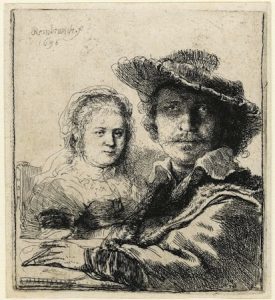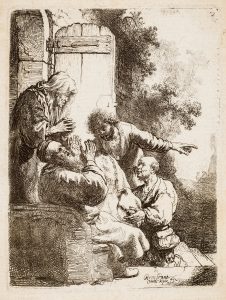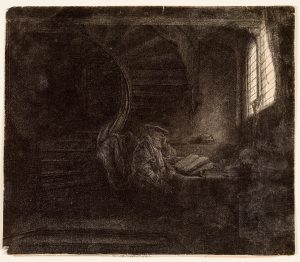
A striking candlelight effect may be the loudest marking of one of the greatest artists in the history of art, but a new exhibit extinguishes it in favor of his other theatrical — and humane — sensibilities.
Detail-soaked biblical passages, scenes of street life and portraits of the distinguished and the marginalized have aligned at the Society of the Four Arts to resurrect a Dutch master’s groundbreaking etchings. Rembrandt van Rijn, the most revered among Holland’s Golden Age artists, may be best known for his dramatic use of light but it is his printmaking methods that Rembrandt: The Sign and the Light focuses on through Feb. 2. Featuring 69 prints that also include landscapes and self-portraits, the exhibition marks the 350th anniversary of Rembrandt’s death in 1669.
The first thing to notice about the works on view is their compact size. Be sure to ask for a magnifying glass at the greeting desk prior to entering the galleries. This is the best way to fully appreciate all the markings, lines and gestures present, particularly in his character studies.

The heightened expression of the protagonist in Man Crying Out, Three Quarters Left: Bust is one of the distinctive characteristics of tronies (face studies). Rembrandt ramps up the emotions erupting out of the unkept bearded man, who is portrayed mouth half-open in an afflicted state. The artist often borrowed from his own likeliness to compose etchings of street characters and several pieces here remind us of what he looked like.
The north gallery contains one of the most famous: Self-Portrait Leaning on a Stone Sill. Dressed in an elaborate period costume and positioned in a confident pose looking straight at us, a long-haired Rembrandt emulates esteemed painters who preceded him. The self-portrait quotes two well-known portraits: Raphael’s Portrait of Baldassare Castiglione, and Titian’s Man with a Quilted Sleeve.
The Pancake Woman offers up a touching snapshot of everyday Dutch life through an elderly woman tasked with the essential function of producing food while hungry customers pile up and hover over her. She is worn out, exhausted and too busy for distractions; not even a dog’s attempt to steal a child’s pancake manages to disrupt her concentration. Rembrandt underscores the woman’s relevance by making her figure stand out from the crowd via an immense amount of detail and saturation lacking in the rest of the scene. The weight of her darkened shape mirrors the burden she carries.
Later, we receive further confirmation of a feeling that starts building up earlier in the show: Rembrandt cared enough about the poor and destitute to not ridicule them. While other artists depicted them as grotesque or undignified, he humanized them. Among the most heartbreaking scenes demonstrating his sympathy toward the impoverished is The Strolling Musicians.
It features two performers with a nonthreatening aspect serenading a family with bagpipes and a hurdy-gurdy. The light emanating from inside the home illuminates the players whose bare feet, hunched backs and ragged clothing signal an arduous life trajectory. The family’s toddler seems entertained by the humble tune while the musicians’ loyal companion, a timid small dog, is kept on a leash. (For the chiaroscuro quality he is known for, stop by Beggar with a Wooden Leg, which is displayed nearby).
Meanwhile, his representations of stories from the Old and New Testaments are predictably sublime and display his famous bold contrast of shadow and light. They are also larger in scale.

One of the most evocative takes narrates the precise moment Jacob hears that his son Joseph has been killed by a wild animal. Delivering the news in Joseph’s Coat Brought to Jacob are Joseph’s half-brothers, who, blinded by jealously, sold him into slavery and fabricated a tragic story. A horrified Jacob raises his arms in agony and pulls away from the coat dripping goat’s blood that the siblings have brought as proof of the tragedy. Standing over him in shock is Joseph’s aunt, Leah, who stares open-mouthed.
Throughout his career, Rembrandt produced more than 300 etchings, engravings, and dry-points. Printmaking’s most obvious benefit is saving time because one matrix can generate multiple impressions; an advantage the artist rendered null in some cases by spending years modifying a single image. Incessant direct observations and a close study of people and everyday life are said to be important contributors to the artistic genius of this prolific painter and portraitist. The show reveals several layers of his multi-step technique, including working nearly the entire surface of a plate to hold a vast volume of ink.

St. Jerome in a Dark Chamber (1642), by Rembrandt van Rijn.
The nocturnal scenes resulting from this exercise are the highlight of The Sign and the Light even if they are the most difficult to appreciate. They are unexpected, almost useless if it weren’t for their cleverness. If they were squeezed of their ink, they would easily feed several lighter prints. A student’s gaze manages to filter through the darkness and penetrate the plane to make eye contact in Student at a Table by Candlelight. Judging by the hand he draws to his temple, he has been at it for a while. A single candle aids his scholarly efforts. Upon close inspection, we realize the young man hasn’t noticed our presence; his eyes actually remain fixated on the book opened before him and so the intimacy of the moment is preserved.
This is among Rembrandt’s sharpest skills; the ability to elevate private and public mundane moments and anonymous faces with a mystique that doesn’t yield a drop of intensity no matter how long the descriptions unveiling the intentions and the setting.